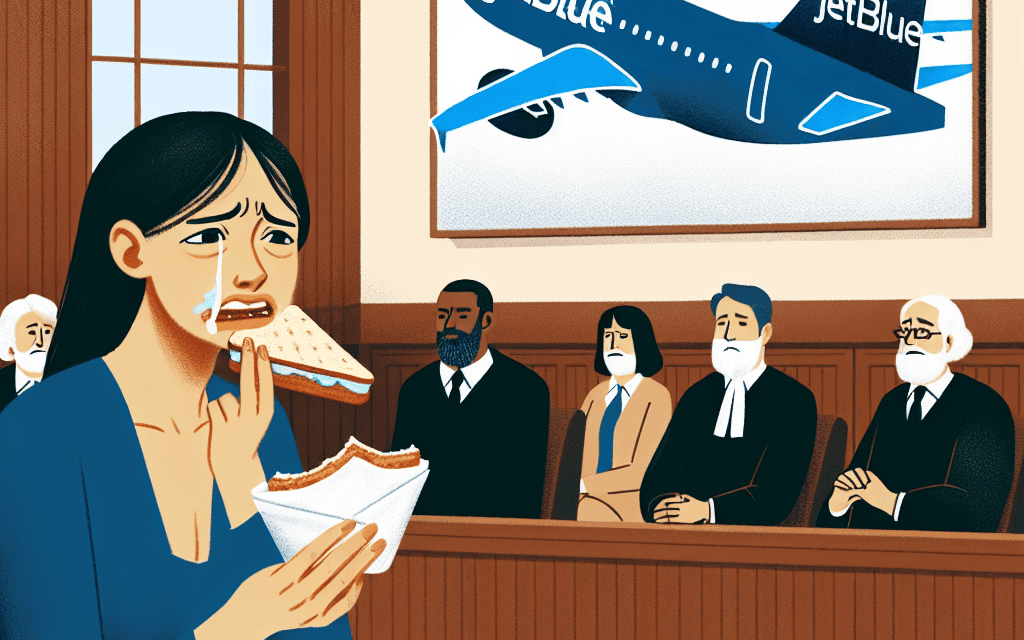“Chilling Consequences: JetBlue Faces Lawsuit Over Ice Cream Mishap”
Introduction
A woman has initiated legal proceedings against JetBlue Airways, alleging that she sustained a tooth injury after consuming an excessively cold ice cream sandwich served during a flight. The lawsuit claims that the airline failed to provide adequate warnings about the potential risk posed by the dessert’s temperature, leading to significant dental damage. This case highlights the broader responsibilities of airlines in ensuring passenger safety and the potential implications of in-flight service practices. The plaintiff seeks compensation for medical expenses and damages related to the incident, bringing attention to the unexpected hazards of seemingly innocuous in-flight amenities.
Legal Implications of Food-Related Injuries on Flights
In recent years, the aviation industry has faced a myriad of challenges, ranging from security concerns to customer service issues. However, a new and unexpected legal challenge has emerged, highlighting the potential implications of food-related injuries on flights. A woman has filed a lawsuit against JetBlue Airways, claiming that she suffered a tooth injury after biting into an excessively cold ice cream sandwich served during her flight. This case brings to light the broader legal implications of food-related injuries on flights, raising questions about airline liability and passenger safety.
The incident in question occurred when the passenger, while enjoying an in-flight meal, bit into an ice cream sandwich that was allegedly too hard, resulting in a chipped tooth. The lawsuit claims that JetBlue failed to ensure the dessert was served at a safe temperature, thus breaching their duty of care to passengers. This case underscores the importance of food safety and quality control in the airline industry, where meals are often prepared and stored under unique conditions.
From a legal perspective, the case against JetBlue hinges on the concept of negligence. To succeed in her claim, the plaintiff must demonstrate that the airline owed her a duty of care, that this duty was breached, and that the breach directly caused her injury. Airlines, like any service provider, are expected to ensure that the food they serve is safe for consumption. This includes maintaining appropriate storage temperatures and ensuring that food items do not pose a risk to passengers.
Moreover, this lawsuit could set a precedent for how similar cases are handled in the future. If the court rules in favor of the plaintiff, it may encourage other passengers who have suffered food-related injuries on flights to pursue legal action. This could lead to increased scrutiny of airline food safety practices and potentially result in stricter regulations governing in-flight meal preparation and service.
In addition to the legal ramifications, this case also highlights the challenges airlines face in maintaining food quality and safety. The unique environment of an aircraft, with its limited space and resources, presents significant obstacles to ensuring that meals are served at optimal conditions. Airlines must balance the need to provide a satisfying dining experience with the imperative to maintain safety standards, a task that is not without its difficulties.
Furthermore, the case raises questions about passenger expectations and the level of responsibility airlines have in meeting those expectations. While passengers may anticipate a certain standard of service, including the quality of food, airlines must navigate the complexities of delivering this service within the constraints of air travel. This includes managing the logistics of food storage and preparation, as well as addressing any potential risks associated with serving meals at high altitudes.
In conclusion, the lawsuit against JetBlue for a tooth injury caused by a cold ice cream sandwich serves as a reminder of the legal and operational challenges airlines face in providing in-flight meals. As this case unfolds, it may prompt airlines to reevaluate their food safety protocols and consider the potential legal implications of their service offerings. Ultimately, ensuring passenger safety and satisfaction remains a priority for the aviation industry, and this case may serve as a catalyst for further improvements in this area.
Passenger Rights: What to Do When Injured by In-Flight Services
In recent developments concerning passenger rights and airline accountability, a woman has filed a lawsuit against JetBlue Airways, claiming that she sustained a tooth injury after biting into an exceptionally cold ice cream sandwich during a flight. This incident has sparked discussions about the responsibilities of airlines in ensuring passenger safety and comfort, particularly when it comes to in-flight services. As air travel becomes increasingly common, understanding the rights of passengers and the obligations of airlines is crucial for both parties involved.
The lawsuit, which has garnered significant media attention, highlights the potential risks associated with seemingly innocuous in-flight amenities. While airlines strive to enhance passenger experience by offering a variety of snacks and meals, the case underscores the importance of ensuring that these offerings do not pose a hazard to passengers. The plaintiff alleges that the ice cream sandwich served on her JetBlue flight was so cold and hard that it caused significant damage to her tooth, leading to pain and the need for dental treatment. This incident raises questions about the standards and procedures airlines have in place to prevent such occurrences.
In light of this case, it is essential for passengers to be aware of their rights when it comes to injuries sustained during flights. The Montreal Convention, an international treaty, governs airline liability for passenger injuries and establishes the framework for compensation claims. Under this convention, airlines are liable for damages sustained in the event of an accident that causes injury to passengers while on board the aircraft or during the process of embarking or disembarking. However, the definition of an “accident” can be subject to interpretation, and passengers may need to demonstrate that the injury was caused by an unexpected or unusual event.
Moreover, passengers should be proactive in documenting any incidents that occur during a flight. This includes taking photographs of the item or condition that caused the injury, obtaining contact information from witnesses, and reporting the incident to the airline’s crew as soon as possible. Prompt reporting not only ensures that the airline is aware of the issue but also strengthens the passenger’s case should they decide to pursue legal action.
For airlines, this lawsuit serves as a reminder of the importance of maintaining high standards in their in-flight services. Ensuring that food and beverages are stored and served at appropriate temperatures is a fundamental aspect of passenger safety. Airlines must regularly review and update their procedures to prevent similar incidents from occurring in the future. Additionally, training staff to handle passenger complaints effectively and empathetically can help mitigate potential legal disputes and enhance customer satisfaction.
In conclusion, the lawsuit against JetBlue for a tooth injury caused by a cold ice cream sandwich brings to light the broader issue of passenger rights and airline responsibilities. As air travel continues to evolve, both passengers and airlines must remain vigilant in upholding safety standards and addressing any concerns that arise. By understanding their rights and taking appropriate action when necessary, passengers can ensure that their travel experiences are both safe and enjoyable. Simultaneously, airlines must prioritize the well-being of their passengers by implementing rigorous safety protocols and fostering a culture of accountability and responsiveness.
The Role of Airlines in Ensuring Passenger Safety and Comfort
In recent years, the aviation industry has faced increasing scrutiny regarding passenger safety and comfort, with airlines striving to meet the expectations of travelers while adhering to stringent regulations. A recent lawsuit filed against JetBlue Airways highlights the complexities involved in ensuring passenger well-being, even in seemingly trivial matters. The case involves a woman who claims to have suffered a tooth injury after biting into an excessively cold ice cream sandwich served during her flight. This incident raises important questions about the responsibilities of airlines in providing not only safe transportation but also a comfortable and risk-free in-flight experience.
Airlines are tasked with the challenging responsibility of maintaining high standards of safety and comfort for their passengers. While safety protocols primarily focus on preventing accidents and ensuring the structural integrity of aircraft, the concept of passenger comfort encompasses a broader range of considerations. These include seating arrangements, cabin temperature, noise levels, and the quality of food and beverages served on board. The lawsuit against JetBlue underscores the importance of the latter, as it brings to light the potential hazards associated with in-flight catering.
The provision of meals and snacks during flights is a standard service offered by most airlines, aimed at enhancing the overall travel experience. However, the preparation and storage of these food items require careful attention to detail to prevent any adverse effects on passengers. In the case of the JetBlue lawsuit, the plaintiff alleges that the ice cream sandwich was served at an extremely low temperature, rendering it too hard to consume safely. This incident suggests that airlines must implement rigorous quality control measures to ensure that food items are stored and served at appropriate temperatures, thereby minimizing the risk of injury.
Moreover, this lawsuit highlights the need for airlines to be proactive in addressing passenger concerns and complaints. Effective communication channels between passengers and airline staff can play a crucial role in identifying potential issues before they escalate into legal disputes. By fostering an environment where passengers feel comfortable voicing their concerns, airlines can take timely corrective actions, thereby enhancing passenger satisfaction and reducing the likelihood of litigation.
In addition to addressing immediate concerns, airlines can also benefit from adopting a more comprehensive approach to passenger safety and comfort. This involves regular training for cabin crew members on best practices for handling in-flight services, including food and beverage distribution. By equipping staff with the necessary skills and knowledge, airlines can ensure that potential risks are identified and mitigated promptly.
Furthermore, collaboration with food suppliers and catering companies is essential to maintain high standards of quality and safety. Airlines should work closely with these partners to establish clear guidelines for the preparation, storage, and transportation of food items. This collaborative approach can help prevent incidents similar to the one involving JetBlue, thereby safeguarding passenger well-being.
In conclusion, the lawsuit against JetBlue serves as a reminder of the multifaceted nature of passenger safety and comfort in the aviation industry. While the primary focus remains on ensuring safe travel, airlines must also pay attention to the finer details of the in-flight experience. By implementing robust quality control measures, fostering open communication with passengers, and collaborating with partners, airlines can enhance their service offerings and uphold their commitment to passenger safety and comfort. As the industry continues to evolve, these efforts will be crucial in maintaining the trust and confidence of travelers worldwide.
Understanding Liability in Airline Food Service Incidents

In recent years, the airline industry has faced increasing scrutiny over various aspects of passenger experience, from seating comfort to in-flight services. A recent lawsuit filed against JetBlue Airways highlights a lesser-discussed area of concern: the safety and quality of in-flight food offerings. The case involves a woman who claims she suffered a tooth injury after biting into an exceptionally cold ice cream sandwich served during her flight. This incident raises important questions about liability and the responsibilities of airlines in ensuring passenger safety, even in seemingly minor aspects such as food service.
To understand the implications of this lawsuit, it is essential to consider the legal framework governing airline liability. Airlines are generally held to a standard of care that requires them to ensure the safety and well-being of their passengers. This duty extends to all services provided during a flight, including the food and beverages offered. When a passenger is injured due to negligence in these services, the airline may be held liable for damages. In this context, the woman’s claim against JetBlue hinges on whether the airline failed to meet its duty of care by serving an ice cream sandwich that was too hard to consume safely.
The case also brings to light the challenges airlines face in maintaining food quality and safety at high altitudes. The logistics of in-flight catering are complex, involving the preparation, storage, and serving of food in a controlled environment. Temperature control is a critical factor, as it affects both the safety and palatability of food items. In this instance, the ice cream sandwich’s temperature may have been improperly managed, leading to its excessively hard state. This raises questions about the protocols JetBlue and other airlines have in place to monitor and adjust food temperatures during flights.
Moreover, the lawsuit underscores the importance of clear communication between airlines and their passengers. Providing adequate warnings or instructions about the consumption of certain food items could potentially mitigate the risk of injury. For example, passengers could be advised to allow frozen items to thaw slightly before consumption. Such measures, while seemingly minor, could play a significant role in preventing similar incidents in the future.
As the case unfolds, it may set a precedent for how similar claims are handled in the airline industry. If the court finds JetBlue liable, it could prompt airlines to reevaluate their food service protocols and implement more stringent safety measures. This could include revising temperature control procedures, enhancing staff training, and improving communication with passengers regarding food safety.
In conclusion, the lawsuit against JetBlue serves as a reminder of the multifaceted nature of airline liability. While the focus often lies on major safety concerns, seemingly minor issues like food service can also have significant legal and financial implications. As airlines strive to enhance passenger experience, they must remain vigilant in all aspects of service delivery, ensuring that even the smallest details are managed with care and precision. This case not only highlights the potential risks associated with in-flight food service but also emphasizes the need for comprehensive safety protocols to protect passengers and uphold the industry’s standards.
The Impact of Lawsuits on Airline Policies and Procedures
In recent years, the aviation industry has witnessed a growing number of lawsuits that have prompted airlines to reevaluate their policies and procedures. A notable case that has captured public attention involves a woman who filed a lawsuit against JetBlue Airways, claiming that she suffered a tooth injury after biting into a cold ice cream sandwich served during her flight. This incident not only highlights the potential for unexpected injuries during air travel but also underscores the broader implications such lawsuits can have on airline operations and customer service protocols.
The lawsuit against JetBlue serves as a reminder of the myriad challenges airlines face in ensuring passenger safety and satisfaction. While the primary focus of airline safety has traditionally been on preventing accidents and ensuring the mechanical integrity of aircraft, incidents like this one illustrate the importance of considering all aspects of the passenger experience. The woman’s claim that the ice cream sandwich was served at an excessively cold temperature, leading to her dental injury, raises questions about the standards and procedures airlines use when serving in-flight meals and snacks.
In response to such legal actions, airlines are often compelled to conduct thorough reviews of their service protocols. This can include reassessing the storage and serving temperatures of food items, as well as providing additional training for flight attendants on how to handle and serve these items safely. Moreover, airlines may also consider revising their menus to include items that pose less risk of injury, thereby minimizing the potential for similar incidents in the future. These changes, while seemingly minor, can have significant implications for the overall passenger experience and the airline’s reputation.
Furthermore, lawsuits like the one filed against JetBlue can lead to broader industry-wide changes. As airlines observe the outcomes of such cases, they may proactively implement new policies to avoid similar legal challenges. This can result in a ripple effect, where a single lawsuit prompts widespread changes across the industry. For instance, airlines might collaborate to establish standardized guidelines for in-flight food service, ensuring consistency and safety across different carriers.
In addition to operational changes, the financial implications of lawsuits cannot be overlooked. Legal battles can be costly, not only in terms of potential settlements or judgments but also in terms of legal fees and the resources required to address the claims. These costs can ultimately impact an airline’s bottom line, potentially leading to increased ticket prices or reduced services as companies seek to offset their expenses. Consequently, airlines have a vested interest in minimizing the risk of lawsuits by proactively addressing potential safety concerns and enhancing their customer service practices.
Moreover, the public relations aspect of such lawsuits is significant. Negative publicity can damage an airline’s brand image, leading to a loss of customer trust and loyalty. In today’s digital age, where news spreads rapidly across social media platforms, airlines must be particularly vigilant in managing their public image. By demonstrating a commitment to passenger safety and satisfaction, airlines can mitigate the negative impact of lawsuits and maintain their competitive edge in a crowded market.
In conclusion, the lawsuit filed against JetBlue for a tooth injury caused by a cold ice cream sandwich serves as a poignant example of how legal actions can influence airline policies and procedures. As airlines strive to enhance passenger safety and satisfaction, they must remain vigilant in addressing potential risks and adapting to the evolving legal landscape. Through proactive measures and industry collaboration, airlines can not only reduce the likelihood of future lawsuits but also ensure a safer and more enjoyable travel experience for all passengers.
Exploring the Challenges of Proving Negligence in In-Flight Injuries
In the realm of aviation, passenger safety and comfort are paramount concerns for airlines. However, incidents occasionally arise that challenge these priorities, leading to legal disputes. A recent case involving a woman who filed a lawsuit against JetBlue Airways highlights the complexities of proving negligence in in-flight injuries. The plaintiff claims that she suffered a tooth injury after biting into an exceptionally cold ice cream sandwich served during her flight. This unusual case underscores the intricate nature of establishing liability and negligence in the context of airline services.
To begin with, the legal framework surrounding in-flight injuries is multifaceted, often involving a blend of aviation law, personal injury law, and consumer protection regulations. In this particular case, the plaintiff must demonstrate that JetBlue failed to meet its duty of care, which is a fundamental element in negligence claims. The duty of care refers to the airline’s responsibility to ensure the safety and well-being of its passengers. However, proving a breach of this duty can be challenging, especially when the injury results from a seemingly innocuous item like an ice cream sandwich.
Moreover, the plaintiff must establish causation, showing that the airline’s actions directly led to her injury. This involves demonstrating that the ice cream sandwich was served at an unreasonably cold temperature, making it hazardous to consume. The challenge lies in proving that the airline’s handling or storage of the dessert deviated from standard practices, thereby constituting negligence. Additionally, the plaintiff must counter any arguments suggesting contributory negligence, where the passenger’s own actions may have contributed to the injury.
Furthermore, the case raises questions about the standard of care expected from airlines in providing food and beverages. While passengers anticipate a certain level of quality and safety in in-flight services, the extent to which airlines are liable for injuries caused by food items remains a gray area. This is particularly true for items like ice cream, which inherently require specific storage conditions to maintain their quality. The plaintiff’s legal team may need to delve into industry standards and guidelines to establish whether JetBlue’s handling of the ice cream sandwich fell short of these expectations.
In addition to the legal complexities, this case also highlights the broader implications for airline policies and procedures. Airlines may need to reassess their food service protocols to prevent similar incidents in the future. This could involve implementing stricter temperature controls for perishable items or providing clearer instructions to passengers regarding the consumption of certain foods. Such measures not only enhance passenger safety but also mitigate the risk of legal disputes arising from in-flight injuries.
In conclusion, the lawsuit against JetBlue for a tooth injury caused by a cold ice cream sandwich serves as a poignant reminder of the challenges involved in proving negligence in in-flight injuries. The case underscores the need for a thorough examination of airline practices and the legal standards governing passenger safety. As the aviation industry continues to evolve, airlines must remain vigilant in upholding their duty of care, ensuring that passenger experiences are not only comfortable but also safe. This case may well set a precedent for how similar incidents are addressed in the future, prompting airlines to refine their service protocols and prioritize passenger well-being.
The Importance of Quality Control in Airline Catering Services
In recent years, the airline industry has faced increasing scrutiny over the quality and safety of its in-flight services, particularly concerning catering. A recent lawsuit filed against JetBlue Airways highlights the critical importance of quality control in airline catering services. The case involves a woman who claims she suffered a tooth injury after biting into an excessively cold ice cream sandwich served during her flight. This incident underscores the need for airlines to implement stringent quality control measures to ensure passenger safety and satisfaction.
Airline catering is a complex operation that involves the preparation, storage, and distribution of meals and snacks to passengers at high altitudes. Given the unique challenges posed by this environment, maintaining the quality and safety of food items is paramount. The lawsuit against JetBlue serves as a stark reminder of the potential consequences of lapses in quality control. When food items are not properly handled or stored, they can become hazardous, leading to incidents such as the one experienced by the plaintiff.
The importance of quality control in airline catering cannot be overstated. It encompasses various aspects, including temperature regulation, proper packaging, and adherence to food safety standards. For instance, temperature control is crucial in preventing foodborne illnesses and ensuring that items like ice cream are served at a safe and palatable consistency. In the case of the JetBlue incident, it appears that the ice cream sandwich was not stored or served at an appropriate temperature, resulting in an unexpected and potentially dangerous experience for the passenger.
Moreover, quality control extends beyond food safety to include the overall passenger experience. Airlines are increasingly competing on the basis of service quality, and catering plays a significant role in shaping passengers’ perceptions. A well-executed in-flight meal service can enhance customer satisfaction and loyalty, while a negative experience can have the opposite effect. Therefore, airlines must prioritize quality control to maintain their reputation and ensure a positive experience for all passengers.
To achieve this, airlines can implement several strategies. First, they should establish comprehensive quality control protocols that cover every stage of the catering process, from food preparation to delivery. This includes regular inspections and audits to ensure compliance with safety standards. Additionally, airlines can invest in staff training to equip their employees with the knowledge and skills necessary to handle food items safely and efficiently. By fostering a culture of quality and safety, airlines can minimize the risk of incidents and enhance the overall passenger experience.
Furthermore, collaboration with reputable catering companies is essential. Airlines should partner with providers that have a proven track record of delivering high-quality and safe food products. By working closely with these partners, airlines can ensure that their catering services meet the highest standards of quality and safety.
In conclusion, the lawsuit against JetBlue serves as a poignant reminder of the critical importance of quality control in airline catering services. As the industry continues to evolve, airlines must remain vigilant in their efforts to ensure the safety and satisfaction of their passengers. By implementing robust quality control measures and fostering strong partnerships with catering providers, airlines can mitigate risks and enhance the overall travel experience. Ultimately, prioritizing quality control is not only a matter of passenger safety but also a key factor in maintaining a competitive edge in the ever-evolving airline industry.
Q&A
1. **What is the lawsuit about?**
A woman filed a lawsuit against JetBlue Airways, claiming she suffered a tooth injury after biting into a cold ice cream sandwich served during a flight.
2. **Who is the plaintiff?**
The plaintiff is a female passenger who was traveling on a JetBlue flight when the incident occurred.
3. **What injury did the plaintiff claim to have sustained?**
The plaintiff claimed to have sustained a tooth injury, specifically a cracked or broken tooth, from biting into the overly cold ice cream sandwich.
4. **What is the plaintiff seeking in the lawsuit?**
The plaintiff is seeking compensation for medical expenses related to dental treatment, as well as damages for pain and suffering.
5. **What was the alleged cause of the injury?**
The alleged cause of the injury was the excessively cold temperature of the ice cream sandwich, which made it hard and difficult to bite into.
6. **How did JetBlue respond to the lawsuit?**
JetBlue’s response to the lawsuit has not been detailed in the available information, but typically, airlines may investigate such claims and respond through legal channels.
7. **Has there been any resolution to the lawsuit?**
As of the latest information, there has been no public resolution to the lawsuit, and it may still be pending in the legal system.
Conclusion
The lawsuit filed by a woman against JetBlue for a tooth injury allegedly caused by a cold ice cream sandwich highlights the potential liabilities airlines face regarding in-flight food service. It underscores the importance of ensuring that food items provided to passengers are safe for consumption and do not pose a risk of injury. This case may prompt airlines to review their food handling and serving procedures to prevent similar incidents in the future. Additionally, it raises questions about the responsibility of airlines to inform passengers about the potential risks associated with consuming certain food items during flights. The outcome of this lawsuit could have implications for how airlines manage and mitigate risks related to in-flight food services.





